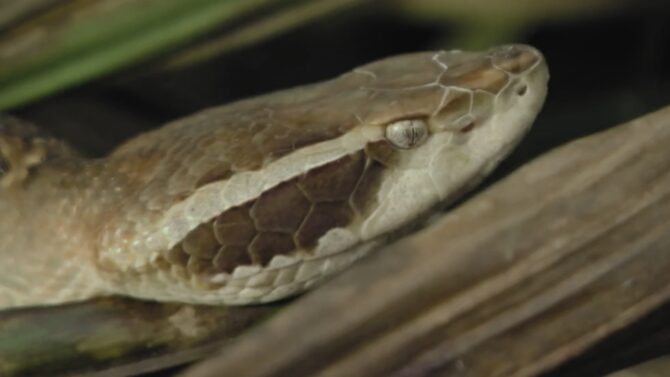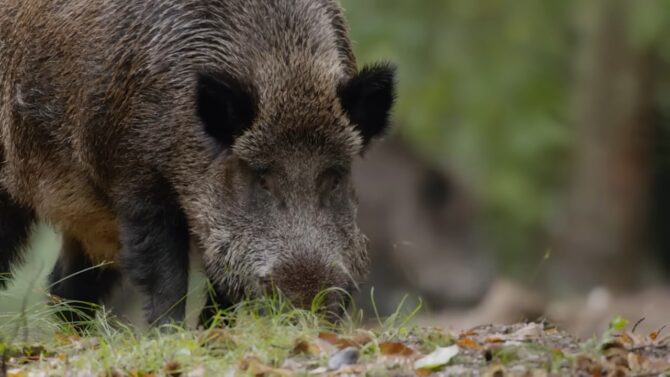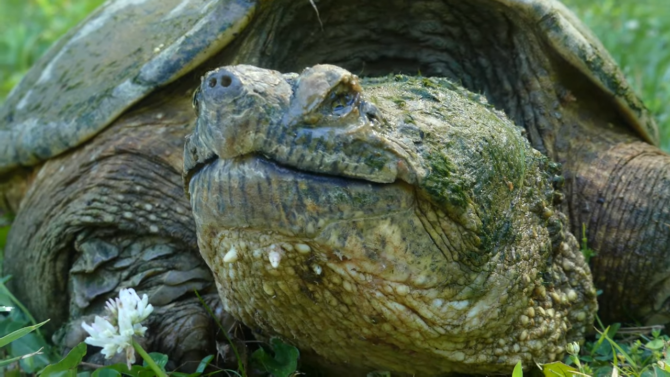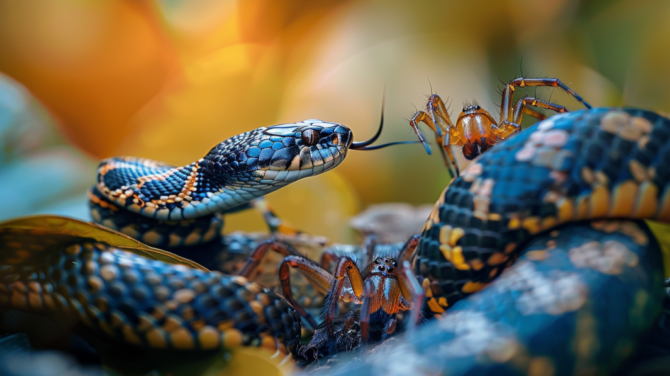Ohio also known as The Buckeye State, and the home of some dangerous animals.
Make sure to do your research and learn about the common dangerous animals in Ohio that you may encounter.
By being aware of these animals and taking precautions, you can help to secure a safe and enjoyable trip.
| Animal | Interesting Facts | Basic Information |
|---|---|---|
| Brown Recluse Spider |
|
|
| Black Widow Spiders |
|
|
| Kissing Bug |
|
|
| Eastern Massasauga Rattlesnake |
|
|
| Black Legged Ticks |
|
|
| Pit Vipers |
|
|
| White-Tailed Deer |
|
|
| Northern Copperhead Snake |
|
|
| Wild Boars |
|
|
| Common Snapping Turtles |
|
|
10. Brown Recluse Spider

The brown recluse spider, also known as fiddle back or violin spider, occurs in the southern and central states of America, extending to Mexico and South America.
In Ohio, they are found indoors and outdoors, often in dark, undisturbed places, including sheds, woodpiles, and under rocks.
The tendency to establish homes inside and around human settlements increases the likelihood of encounters.
Recluse spiders are tiny insects, usually growing 6 to 20 mm long. Their color ranges from yellowish to grayish brown, with a small dark head and notably long legs.
Although small, these insects pack a venomous bite that may be painless at first, but end up causing symptoms like nausea, lesions, fever, and necrosis.
Luckily, recluse bites are rare and they only attack when you push them.
The only problem is that they resemble common house spiders when seen from a distance, and many fail to realize that they are handling a deadly species.
While often mistaken for the brown recluse due to their similar appearance, wolf spiders are generally larger and more robust, lacking the distinctive violin-shaped marking on their backs.
How Harmful is a Brown Recluse?
Brown recluse spider bites typically only cause cutaneous findings that are localized but sometimes can progress to systemic injury and, rarely, death.
Most of these patients will present to the emergency department where they will encounter an ER nurse and emergency medicine physician or physician assistant.
Should I Be Scared of A Brown Recluse?
They usually will only bite if they feel threatened or trapped, so it is best to stay away from them.
The venom brown recluse spiders inject when they bite produces a stinging sensation and intense pain.
This venom may produce necrosis, or dead tissue, and leave behind an ulcerating sore.
9. Black Widow Spiders
Black widow spiders are another venomous spider species found in Ohio.
Their bites can cause pain, nausea, and breathing difficulties, and may require medical attention.
Black widows are poisonous arachnids—animals that have a skeleton outside their body, a segmented body, and eight jointed legs.
They are not insects. Their deadly poison is said to be 15 times stronger than rattlesnake venom.
Did you know…..
Wolf spiders will hunt and eat brown recluse spiders (also known as fiddlebacks), in addition to venomous black widow spiders, cockroaches, crickets, beetles and silverfish. Please don’t squish them. pic.twitter.com/br6jD5xX1H — Mimi Joeckle (@cantcancelmimi) March 25, 2024
After 15 minutes of biting, dull muscle pain spreads from the bite area to the whole body. If the bite is on the upper body, you will usually feel most of the pain in your chest.
8. Kissing Bug

The members of the Triatominae, a subfamily of the Reduviidae, are also known as conenose bugs, kissing bugs, or vampire bugs.
Other local names for them used in the Americas include barbeiros, vinchucas, pitos, chipos and chinches.
Did you know that it is called a kissing bugs because they tend to bite people’s faces.
These bugs are present in the southern United States, including Ohio.
If a kissing bug bites you it can cause patches of bites, often around the mouth.
The bites are usually painless, but they may swell and look like hives. Itching from the bites may last a week.
What Kills Kissing Bugs?
To treat Kissing Bugs, apply an outdoor treatment of Supreme IT every 3 months to maintain control.
Indoors, apply Fipro Aerosol directly to cracks and crevices. Exclusion and sealing of entry points are some of the best ways to prevent Kissing bug re-infestation.
7. Eastern Massasauga Rattlesnake

The Eastern Massasauga Rattlesnake ranges from western New York and southern Ontario to eastern Iowa and Missouri.
Today, this snake occurs in isolated places in glaciated parts of western and northern Ohio (the Great Lakes region).
This snake lives in bogs, swamps, and wet prairies.
It prefers wetland habitats and can be dangerous if disturbed. But it is not the most deadliest snake in Ohio.
Timber rattlesnakes took the number one By their large size, timber rattlesnakes are the most dangerous snakes in northeastern America.
They may attain a length in excess of six feet, wildlife officials say, but average 40 inches in length.
6. Blacklegged (Deer) Tick
Blacklegged ticks (a.k.a deer ticks) take 2 years to complete their life cycle from eggs and larvae in one calendar year to nymphs and adults in the next. This tick is encountered predominately in deciduous forests as well as tall grasslands and shrubs bordering forest edges.
Their distribution relies greatly on the distribution of their reproductive host, white-tailed deer. Both the poppy seed-sized nymph stage and the larger adult female stage are responsible for transmitting diseases such as Lyme disease, Babesiosis, and Anaplasmosis.
5. Pit Vipers

The Crotalinae, commonly known as pit vipers, or pit adders, are a subfamily of vipers found in Asia and the Americas. Like all other vipers, they are venomous. They are distinguished by the presence of a heat-sensing pit organ located between the eye and the nostril on both sides of the head.
Pit vipers’ venom can be strictly neurotoxic with virtually no local signs of envenomation. Venom consists of 90% water and has a minimum of 10 enzymes and 3 to 12 nonenzymatic proteins and peptides in any individual snake.
What Happens if A Pit Viper Bites You?
Dry bites or bites where only a very small amount of venom is injected may cause slight bleeding, pain, and swelling at the bite injury. If a moderate amount of venom was injected, you are more likely to have severe pain, swelling of the whole limb, and general ill feelings, such as nausea, vomiting, and weakness.
4. White-Tailed Deer

White-tailed deer are found in all 88 Ohio counties and thrive in many different habitats.
In late spring, female deer give birth to fawns; twins and triplets are common if high-quality food sources are available.
While they may seem harmless, they can be dangerous if startled or threatened and are responsible for many vehicle accidents each year.
White-tailed deer have been in Ohio since the end of the last Ice Age.
Ohio’s native people used the deer’s meat for food, the hide for clothing, and the bones and antlers for tools.
Indians also used hides, antlers, and bones for ceremonial purposes.
3. Northern Copperhead Snake

One of three venomous snakes found in Ohio (and other eastern United States regions), the Northern copperhead only bites in defense when directly threatened. Bites are rarely fatal, though can cause pain and sickness. A ground-dwelling snake is difficult to spot amongst a blanket of fallen leaves so step carefully!
2. Wild Boars

In Ohio, adults range in size from 125–200 pounds.
Larger individuals do occur, but in Ohio, they rarely exceed 350 pounds. Feral swine tracks look similar to white-tailed deer tracks but have more rounded toes and the dew claws are wider than the toes. Wild boars are omnivorous, aggressive animals with sharp tusks.
They are known to attack humans if provoked.
Wild boars are nocturnal animals (active during the night).
They will spend 12h in sleep during the day, hidden in the nests made of leaves. An acute sense of smell allows wild boars to detect an edible root or tuber 25 cm (10 inches) below the soil.
1. The Snapping Turtle

It is the largest turtle in Ohio.
Terrapins, a related species often confused with turtles, prefer brackish or saltwater habitats, unlike these freshwater turtles. They seldom bask in the sun except in early spring; therefore, though they are very abundant they are not seen as frequently as most other turtles.
It’s not just a myth that they can bite a finger off.
Their Bite Is No Joke, but It Might Not Be as Bad as You Think
They don’t call them snapping turtles for nothing, that’s for sure. And it’s not just a myth that they can bite a finger off.
They can and have done it, according to Nature Discovery.
The average common snapping turtle can bite with a force of about 210 Newtons; alligator snapping turtles aren’t quite as powerful, with a bite force of 160 Newtons.
That may seem pretty impressive, but a little context may prove otherwise. Take, for example, lions. They can generate 4,450 Newtons of bite force.
Even we humans can do much better than snapping turtles, generating 1,100 Newtons of bite force when biting with our second molars, Nature Discovery reports.
Snapping turtles can inflict a lot of damage with their bites in part because their jaws are sharp and edged.
It’s always a good idea to give snapping turtles — and all wildlife, for that matter — a wide berth, and this is especially true when they are on land.
While these turtles aren’t usually aggressive when in the water, they can be on land, according to the Illinois Natural History Survey.
This could be because snapping turtles spend most of their time in the water, usually only coming on land during nesting season.






